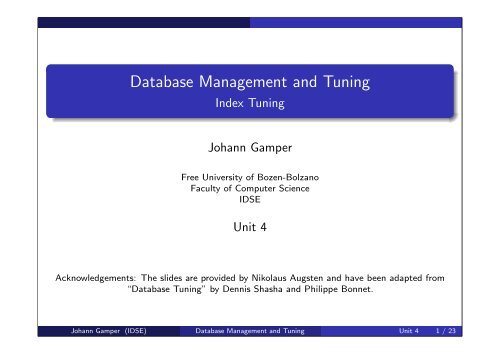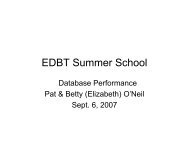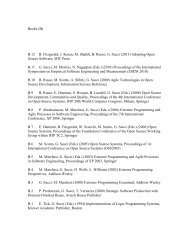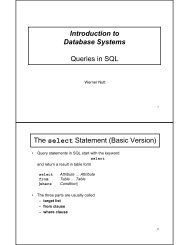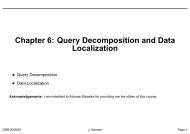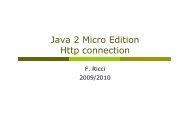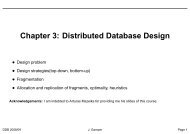Database Management and Tuning - Faculty of Computer Science ...
Database Management and Tuning - Faculty of Computer Science ...
Database Management and Tuning - Faculty of Computer Science ...
You also want an ePaper? Increase the reach of your titles
YUMPU automatically turns print PDFs into web optimized ePapers that Google loves.
<strong>Database</strong> <strong>Management</strong> <strong>and</strong> <strong>Tuning</strong><br />
Index <strong>Tuning</strong><br />
Johann Gamper<br />
Free University <strong>of</strong> Bozen-Bolzano<br />
<strong>Faculty</strong> <strong>of</strong> <strong>Computer</strong> <strong>Science</strong><br />
IDSE<br />
Unit 4<br />
Acknowledgements: The slides are provided by Nikolaus Augsten <strong>and</strong> have been adapted from<br />
“<strong>Database</strong> <strong>Tuning</strong>” by Dennis Shasha <strong>and</strong> Philippe Bonnet.<br />
Johann Gamper (IDSE) <strong>Database</strong> <strong>Management</strong> <strong>and</strong> <strong>Tuning</strong> Unit 4 1 / 23
Outline<br />
1 Index <strong>Tuning</strong><br />
Index Types<br />
2 Conclusion<br />
Johann Gamper (IDSE) <strong>Database</strong> <strong>Management</strong> <strong>and</strong> <strong>Tuning</strong> Unit 4 2 / 23
What is an Index?<br />
Index <strong>Tuning</strong><br />
Index Types<br />
An index is a data structure that supports efficient access to data:<br />
Condition<br />
on<br />
attribute<br />
value<br />
index<br />
Set <strong>of</strong><br />
Records<br />
Matching<br />
records<br />
(search key)<br />
Index tuning essential to performance!<br />
Improper index selection can lead to:<br />
indexes that are maintained but never used<br />
files that are scanned in order to return a single record<br />
multitable joins that run for hours or days<br />
Johann Gamper (IDSE) <strong>Database</strong> <strong>Management</strong> <strong>and</strong> <strong>Tuning</strong> Unit 4 3 / 23
Key <strong>of</strong> an Index<br />
Index <strong>Tuning</strong><br />
Index Types<br />
Search key or simply “key” <strong>of</strong> an index:<br />
single attribute or sequence <strong>of</strong> attributes<br />
values on key attributes used to access records in table<br />
Sequential Key:<br />
value is monotonic with insertion order<br />
examples: time stamp, counter<br />
Non-sequential Key:<br />
value unrelated to insertion order<br />
examples: social security number, last name<br />
Note: index key different from key in normalization theory<br />
normalization theory: key attributes have unique values<br />
index key: not necessarily unique<br />
Johann Gamper (IDSE) <strong>Database</strong> <strong>Management</strong> <strong>and</strong> <strong>Tuning</strong> Unit 4 4 / 23
Index Characteristics<br />
Index <strong>Tuning</strong><br />
Index Types<br />
Indexes can <strong>of</strong>ten be viewed as trees (B + -tree, hash)<br />
some nodes are in main memory (e.g., root)<br />
nodes deeper down in tree are less likely to be in main memory<br />
Number <strong>of</strong> levels: number <strong>of</strong> nodes in root-leaf path<br />
a node is typically a disk block<br />
one block read required per level<br />
reading a block costs several milliseconds (involves disk seek)<br />
Fanout: number <strong>of</strong> children a node can have<br />
large fanout means few levels<br />
Overflow strategy: insert into a full node n<br />
B + -tree: split n into n <strong>and</strong> n ′ , both at same distance from root<br />
overflow chaining: n stores pointer to new node n ′<br />
Johann Gamper (IDSE) <strong>Database</strong> <strong>Management</strong> <strong>and</strong> <strong>Tuning</strong> Unit 4 5 / 23
Sparse vs. Dense<br />
Index <strong>Tuning</strong><br />
Index Types<br />
Sparse index: pointers to disk pages<br />
at most one pointer per disk page<br />
usually much less pointers than records<br />
P1<br />
P2<br />
Pi<br />
Dense index: pointers to individual records<br />
one key per record<br />
usually more keys than sparse index<br />
optimization: store repeating keys only once,<br />
followed by pointers<br />
record<br />
record<br />
record<br />
Johann Gamper (IDSE) <strong>Database</strong> <strong>Management</strong> <strong>and</strong> <strong>Tuning</strong> Unit 4 6 / 23
Sparse vs. Dense<br />
Index <strong>Tuning</strong><br />
Index Types<br />
Efficiency <strong>of</strong> index depends highly on the number <strong>of</strong> levels<br />
Example: levels <strong>of</strong> B-tree<br />
pointers require 6 bytes <strong>and</strong> keys 4 bytes<br />
approx. 400 key-pointer pairs fit on a 4K page<br />
B-tree with 64M key-pointer pairs has 3 levels (1, 400, 160.000 nodes)<br />
keys require 94 bytes<br />
approx. 40 key-pointer pairs fit per page<br />
B-tree requires 5 levels<br />
Some systems <strong>of</strong>fer key compression techniques to increase the fanout<br />
(reduce the number <strong>of</strong> levels)<br />
come at a relatively small processor cost<br />
Prefix compression<br />
in non-leaf nodes only a prefix <strong>of</strong> the key is stored<br />
e.g., Smith, Smoot, Smythe → Smi, Smo, Smy<br />
COMPRESS clause in Oracle CREATE INDEX<br />
Johann Gamper (IDSE) <strong>Database</strong> <strong>Management</strong> <strong>and</strong> <strong>Tuning</strong> Unit 4 7 / 23
Sparse vs. Dense<br />
Index <strong>Tuning</strong><br />
Index Types<br />
Number <strong>of</strong> pointers:<br />
ptrs in dense index = records per page × ptrs in sparse index<br />
Pro sparse: less pointers<br />
typically record size is smaller than page size<br />
less pointers result in less levels (<strong>and</strong> disk accesses)<br />
uses less space<br />
Pro dense: index may “cover” query<br />
Johann Gamper (IDSE) <strong>Database</strong> <strong>Management</strong> <strong>and</strong> <strong>Tuning</strong> Unit 4 8 / 23
Covering Index<br />
Index <strong>Tuning</strong><br />
Index Types<br />
Covering index:<br />
answers read query within index structure<br />
fast, since data is not accessed<br />
Example 1: dense index on lastname<br />
SELECT COUNT(lastname) WHERE lastname=’Smith’<br />
Example 2: dense index on A, B, C (in that order)<br />
covered query:<br />
covered query, but not prefix:<br />
SELECT B, C<br />
FROM R<br />
WHERE A = 5<br />
SELECT A, C<br />
FROM R<br />
WHERE B = 5<br />
non-covered query: D requires data access<br />
SELECT B, D<br />
FROM R<br />
WHERE A = 5<br />
Johann Gamper (IDSE) <strong>Database</strong> <strong>Management</strong> <strong>and</strong> <strong>Tuning</strong> Unit 4 9 / 23
Index <strong>Tuning</strong><br />
Clustering vs. Non-Clustering<br />
Index Types<br />
Clustering index on attribute X<br />
(also primary index)<br />
records are grouped by attribute X on disk<br />
B + -tree: records sorted by attribute X<br />
only one clustering index per table<br />
dense or sparse<br />
Non-clustering index on attribute X<br />
(also secondary index)<br />
no constraint on table organization<br />
more than one index per table<br />
always dense<br />
Records<br />
Records<br />
Johann Gamper (IDSE) <strong>Database</strong> <strong>Management</strong> <strong>and</strong> <strong>Tuning</strong> Unit 4 10 / 23
Clustering Indexes<br />
Index <strong>Tuning</strong><br />
Index Types<br />
Can be sparse:<br />
fewer pointers than non-clustering index (always dense!)<br />
if record is small, save one disk access per record access<br />
Good for multi-point queries:<br />
equality access on non-unique attribute<br />
all result records are on consecutive pages<br />
example: look up last name in phone book<br />
Good for range, prefix, ordering queries:<br />
works if clustering index is implemented as B + -tree<br />
prefix example: look up all last names starting with ’St’ in phone book<br />
result records are on consecutive pages<br />
Good for equality join:<br />
fast also for join on non-key attributes<br />
index on one table: indexed nested-loop<br />
index on both tables: merge-join<br />
Overflow pages reduce efficiency:<br />
if disk page is full, overflowing records go to overflow pages<br />
overflow pages require additional disk accesses<br />
Johann Gamper (IDSE) <strong>Database</strong> <strong>Management</strong> <strong>and</strong> <strong>Tuning</strong> Unit 4 11 / 23
Index <strong>Tuning</strong><br />
Index Types<br />
Equality Join with Clustering Index<br />
Example query:<br />
SELECT Employee.ssnum, Student.course<br />
FROM Employee, Student<br />
WHERE Employee.firstname = Student.firstname<br />
Index on Emplyee.firstname: use index nested loop join<br />
for each student look up employees with same first name<br />
all matching employees are on consecutive pages<br />
Index on both firstname attributes: use merge join<br />
read both tables in sorted order <strong>and</strong> merge (B + -tree)<br />
each page read exactly once<br />
works also for hash indexes with same hash function<br />
Johann Gamper (IDSE) <strong>Database</strong> <strong>Management</strong> <strong>and</strong> <strong>Tuning</strong> Unit 4 12 / 23
Index <strong>Tuning</strong><br />
Index Types<br />
Clustering Index <strong>and</strong> Overflow Pages<br />
Why overflow pages?<br />
clustering index stores records on consecutive disk pages<br />
insertion between two consecutive pages not possible<br />
if disk page is full, overflowing records go to overflow pages<br />
Additional disk access (seek) for overflow page: reduced speed<br />
Overflow pages can result from:<br />
inserts<br />
updates that change key value<br />
updates that increase record size (e.g., replace NULL by string)<br />
Reorganize index:<br />
invoke special tool<br />
or simply drop <strong>and</strong> re-create index<br />
Johann Gamper (IDSE) <strong>Database</strong> <strong>Management</strong> <strong>and</strong> <strong>Tuning</strong> Unit 4 13 / 23
Overflow Strategies<br />
Index <strong>Tuning</strong><br />
Index Types<br />
Tune free space in disk pages:<br />
Oracle, DB2: pctfree (0 is full), SQLServer: fillfactor (100 is full)<br />
free space in page is used for new or growing records<br />
little free space: space efficient, reads are faster<br />
much free space: reduced risk <strong>of</strong> overflows<br />
Overflow strategies:<br />
split: split full page into two half-full pages <strong>and</strong> link new page<br />
e.g., A → B → C, splitting B results in A → B ′ → B ′′ → C<br />
(SQLServer)<br />
chaining: full page has pointer to overflow page (Oracle)<br />
append: overflowing records <strong>of</strong> all pages are appended at the end <strong>of</strong><br />
the table (DB2)<br />
Johann Gamper (IDSE) <strong>Database</strong> <strong>Management</strong> <strong>and</strong> <strong>Tuning</strong> Unit 4 14 / 23
Non-Clustering Index<br />
Index <strong>Tuning</strong><br />
Index Types<br />
Always useful for point queries.<br />
Particularly good if index covers query.<br />
Critical tables: covering index on all relevant attribute combinations<br />
Multi-point query (not covered): only if not too selective<br />
nR: number <strong>of</strong> records returned by query<br />
nP: number <strong>of</strong> disk pages in table<br />
the nR records are uniformly distributed over all pages<br />
thus query will read min(nR, nP) disk pages<br />
Index may slow down highly selective multi-point query:<br />
scan is by factor 2–10 faster than accessing all pages with index<br />
thus nR should be significantly smaller than nP<br />
Johann Gamper (IDSE) <strong>Database</strong> <strong>Management</strong> <strong>and</strong> <strong>Tuning</strong> Unit 4 15 / 23
Index <strong>Tuning</strong><br />
Index Types<br />
Non-Clustering Index <strong>and</strong> Multi-point Queries – Example<br />
Example 1:<br />
records size: 50B<br />
page size: 4kB<br />
attribute A takes 20 different values (evenly distributed among records)<br />
does non-clustering index on A help?<br />
Evaluation:<br />
nR = n/20 (n is the total number <strong>of</strong> records)<br />
nP = n/80 (80 records per page)<br />
n/20 > n/80 thus index does not help<br />
Example 2: as above, but record size is 2kB<br />
Evaluation:<br />
nR = n/20 (n is the total number <strong>of</strong> records)<br />
nP = n/2 (2 records per page)<br />
n/20
Index <strong>Tuning</strong><br />
Index Types<br />
Clustering vs. Non-Clustering Index<br />
1<br />
clustered nonclustered no index<br />
Throughput ratio<br />
0.8<br />
0.6<br />
0.4<br />
0.2<br />
0<br />
SQLServer Oracle DB2<br />
multi-point query with selectivity 100/1M records (0.01%)<br />
clustering index much faster than non-clustering index<br />
full table scan (no index) orders <strong>of</strong> magnitude slower than index<br />
DB2 UDB V7.1, Oracle 8.1, SQL Server 7 on Windows 2000<br />
Johann Gamper (IDSE) <strong>Database</strong> <strong>Management</strong> <strong>and</strong> <strong>Tuning</strong> Unit 4 17 / 23
Index <strong>Tuning</strong><br />
Index Types<br />
Covering vs. Non-Covering Index<br />
70<br />
Throughput (queries/sec)<br />
60<br />
50<br />
40<br />
30<br />
20<br />
10<br />
0<br />
SQLServer<br />
covering<br />
covering - not<br />
ordered<br />
non clustering<br />
clustering<br />
prefix match query on sequence <strong>of</strong> attributes<br />
covering: index covers query, query condition on prefix<br />
covering, not ordered: index covers query, but condition not prefix<br />
non-clustering: non-covering index, query condition on prefix<br />
clustering: sparse index, query condition on prefix<br />
SQL Server 7 on Windows 2000<br />
Johann Gamper (IDSE) <strong>Database</strong> <strong>Management</strong> <strong>and</strong> <strong>Tuning</strong> Unit 4 18 / 23
Index <strong>Tuning</strong><br />
Non-Covering vs. Table Scan<br />
Index Types<br />
Throughput (queries/sec)<br />
scan<br />
non clustering<br />
0 5 10 15 20 25<br />
% <strong>of</strong> selected records<br />
query: range query<br />
non clustering: non-clustering non-covering index<br />
scan: no index, i.e., table scan required<br />
index is faster if less than 15% <strong>of</strong> the records are selected<br />
DB2 UDB V7.1 Windows 2000<br />
Johann Gamper (IDSE) <strong>Database</strong> <strong>Management</strong> <strong>and</strong> <strong>Tuning</strong> Unit 4 19 / 23
Index <strong>Tuning</strong><br />
Index Maintenance - DB2<br />
Index Types<br />
DB2<br />
Throughput<br />
(queries/sec)<br />
50<br />
40<br />
30<br />
20<br />
10<br />
0<br />
No maintenance<br />
Maintenance<br />
0 20 40 60 80 100<br />
% Increase in Table Size<br />
query: batch <strong>of</strong> 100 multi-point queries, pctfree=0 (data pages full)<br />
performance degrades with insertion<br />
overflow records simply appended<br />
query traverses index <strong>and</strong> then scans all overflow records<br />
reorganization helps<br />
DB2 UDB V7.1 on Windows 2000<br />
Johann Gamper (IDSE) <strong>Database</strong> <strong>Management</strong> <strong>and</strong> <strong>Tuning</strong> Unit 4 20 / 23
Index <strong>Tuning</strong><br />
Index Types<br />
Index Maintenance - SQL Server<br />
SQLServer<br />
Throughput<br />
(queries/sec)<br />
No maintenance<br />
Maintenance<br />
0 20 40 60 80 100<br />
% Increase in Table Size<br />
fillfactor=100 (data pages full)<br />
performance degrades with insertion<br />
overflow chain maintained for overflowing page<br />
extra disk access<br />
reorganization helps<br />
SQL Server 7 on Windows 2000<br />
Johann Gamper (IDSE) <strong>Database</strong> <strong>Management</strong> <strong>and</strong> <strong>Tuning</strong> Unit 4 21 / 23
Index <strong>Tuning</strong><br />
Index Maintenance - Oracle<br />
Index Types<br />
Oracle<br />
Throughput<br />
(queries/sec)<br />
No<br />
maintenance<br />
0 20 40 60 80 100<br />
% Increase in Table Size<br />
pctfree = 0 (data pages full), performance degrades with insertion<br />
all indexes in Oracle are non-clustering<br />
index-organized table is clustered by primary key<br />
recreating index does not reorganize table<br />
maintenance: export <strong>and</strong> re-import table to reorganize :-(<br />
Oracle 8i EE on Windows 2000<br />
Johann Gamper (IDSE) <strong>Database</strong> <strong>Management</strong> <strong>and</strong> <strong>Tuning</strong> Unit 4 22 / 23
Summary<br />
Conclusion<br />
Index tuning<br />
Dense vs. sparse index<br />
Clustering vs. non-clustering index<br />
Johann Gamper (IDSE) <strong>Database</strong> <strong>Management</strong> <strong>and</strong> <strong>Tuning</strong> Unit 4 23 / 23


